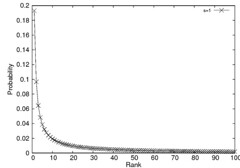When I carry out some experiments, I usually make synthetic data sets generated by some probability distributions. Especially, Zipf distribution is frequently used for a synthetic data set. Zipf distribution is one of the discrete power law probability distributions. You can get detail information from Zipf’s law in Wikipedia. Anyway, I attached my own java class for zip distribution. Below graphs are generated by my own java code and the gnuplot.

import java.util.Random; public class ZipfGenerator { private Random rnd = new Random(System.currentTimeMillis()); private int size; private double skew; private double bottom = 0; public ZipfGenerator(int size, double skew) { this.size = size; this.skew = skew; for(int i=1;i < size; i++) { this.bottom += (1/Math.pow(i, this.skew)); } } // the next() method returns an random rank id. // The frequency of returned rank ids are follows Zipf distribution. public int next() { int rank; double friquency = 0; double dice; rank = rnd.nextInt(size); friquency = (1.0d / Math.pow(rank, this.skew)) / this.bottom; dice = rnd.nextDouble(); while(!(dice < friquency)) { rank = rnd.nextInt(size); friquency = (1.0d / Math.pow(rank, this.skew)) / this.bottom; dice = rnd.nextDouble(); } return rank; } // This method returns a probability that the given rank occurs. public double getProbability(int rank) { return (1.0d / Math.pow(rank, this.skew)) / this.bottom; } public static void main(String[] args) { if(args.length != 2) { System.out.println("usage: ./zipf size skew"); System.exit(-1); } ZipfGenerator zipf = new ZipfGenerator(Integer.valueOf(args[0]), Double.valueOf(args[1])); for(int i=1;i <= 100; i++) System.out.println(i+" "+zipf.getProbability(i)); } }

Recent Comments